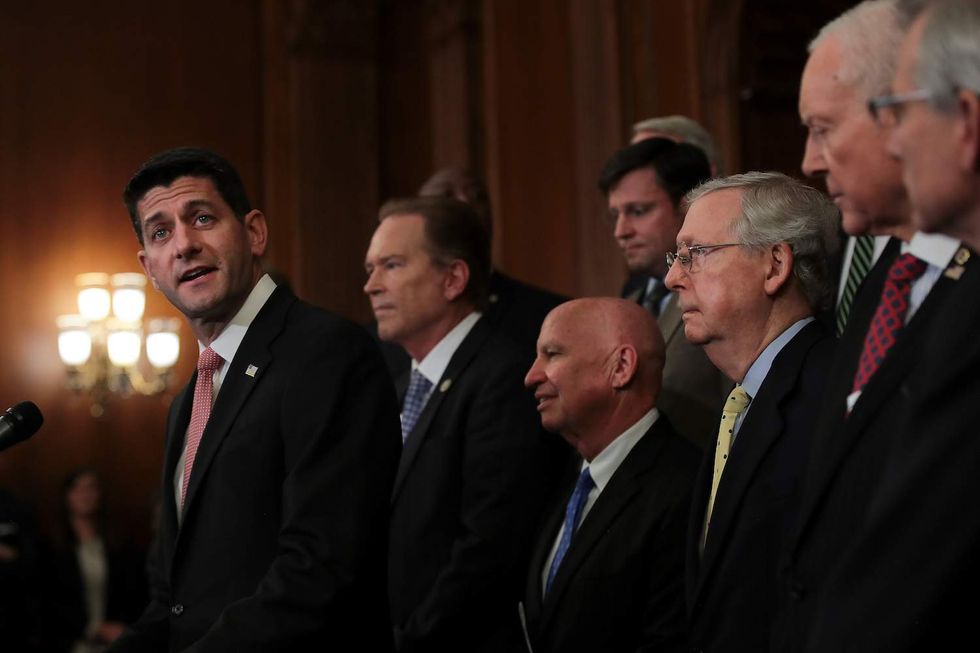
Republican leaders unveiled their tax plan, which includes no changes to the 401(k) program and also calls for lower corporate taxes to 20 percent from 35 percent. (Drew Angerer/Getty Images)

House Republicans rolled out the Tax Cuts and Jobs Act plan on Thursday, outlining proposed tax cuts and reform. The $1.51 trillion plan came a day later than originally scheduled.
“With this plan, we are making pro-growth reforms," House Speaker Paul D. Ryan (R-Wis.) said. "So that, yes, America can compete with the rest of the world,” according to the New York Times, which published a copy of the plan's highlights.
Prior to Thursday's unveiling, some Republicans said they wanted to significantly reduce 401(k) contributions to offset the tax cuts, but it now appears there will be no change to the amount American's can contribute to their plans. Last week, President Donald Trump made a phone call to Ways and Means Chairman Kevin Brady (R-Texas) urging him to drop the plan that had many lawmakers stirred up.
The GOP framework is a long way from becoming law, but here's a breakdown some of the plan's important points.
• Low- and middle-income Americans would be liable for zero taxes for the first $12,000 for single filers and $24,000 for married filers.
• The new single-filer tax rate schedule would be 12 percent on income up to $45,000, 25 percent on income up to $200,000 and 35 percent up to $500,000. Top earners over $500,000 rate would remain at 39.6 percent. The current tax rate schedule is 10 percent for $0 to $9,325; 15 percent for $9,326 to $37,950; 25 percent for $37,951 to 91,900; 28 percent for $91,901 to $191,650; 33 percent for $191,651 to $416,700; 35 percent for $416,701 to $418,400; and 39.6 percent for $418,401 and above.
• The new married-filers tax rate schedule would be 12 percent on income up to $90,000, 25 percent on income up to $260,000, 35 percent on income up to $1 million. Top earners over $1 million would remain at 39.6 percent. Under the current tax rate schedule, married filers pay 10 percent for $0 to $18,650; 15 percent for $18,651 to $75,900; 25 percent for $75,901 to $153,100; 28 percent for $153,101 to $233,350; 33 percent for $233,351 to $416,700; 35 percent for $416,701 to $470,700; and 39.6 percent for $470,701 and above.
• The plan expands the Child Tax Credit from $1,000 to $1,600 to help parents with the cost of raising children. It would include a new Family Credit of $300 for each parent and non-child dependent to help all families with their everyday expenses. The new credit would expire after five years.
• The plan also preserves the Child and Dependent Care Tax Credit to help families care for their children and older dependents such as a disabled grandparent who may need additional support.
• There are no changes to 401(k) plans.
• The plan preserves earned income tax credit.
• The mortgage interest deduction will be preserved for existing loans and up to $500,000 on new mortgage loans.
• It repeals the alternative minimum tax.
• The plan doubles the estate tax deduction and in six years, repeals it. Currently, a single taxpayer can leave up to $5.49 million tax-free to his heirs and nearly $11 million for couples. Above that amount, the estate is taxed at 40 percent.
• The plan lowers corporate taxes to 20 percent from 35 percent.
• The taxes on small and medium businesses would be capped at 25 percent.
• It allows businesses to immediately write-off the full cost of new equipment.
• The plan protects the ability for small businesses to write off interest from loans. Currently, the investment is depreciated over a number of years. The rate and number years can vary based on the type and amount of the investment.
• It preserves the tax credit for research and development.
• The plan prevents jobs, headquarters and research from moving overseas by removing incentives that now reward companies for shifting jobs, research and manufacturing overseas.
Republicans are hoping to move the plan quickly through the House and forward it on to the Senate, later this month, according to Politico. However, a competing plan from Senate Republicans is expected to be introduced next week.
There will likely be a number of changes and compromises made before the final bill lands on Trump's desk.
Access the section-by-section summary of the Tax Cuts and Jobs Act here.